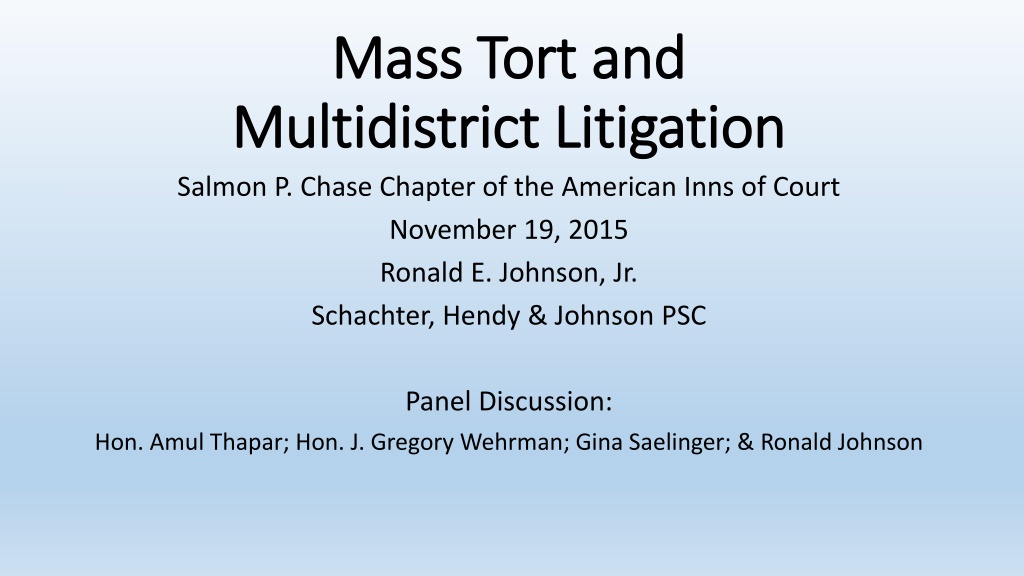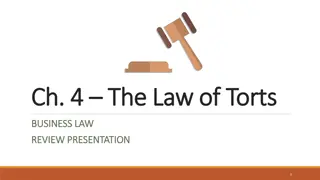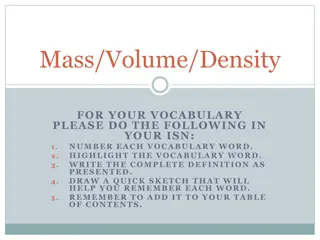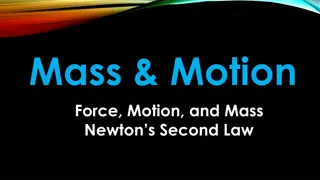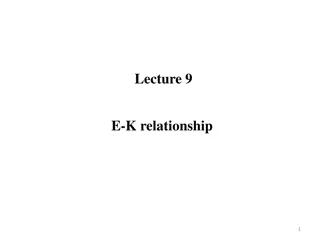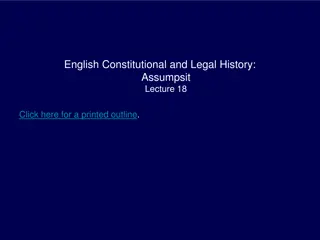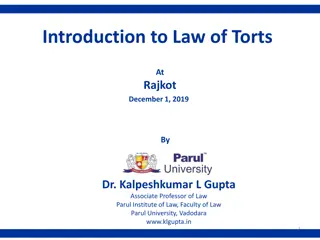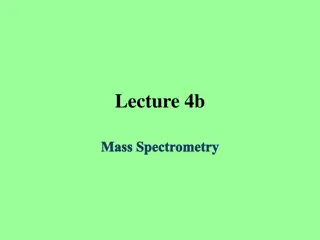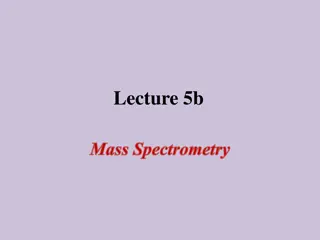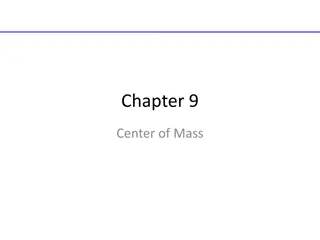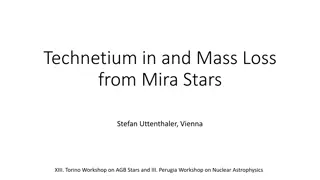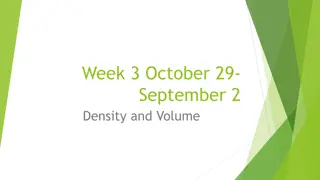Understanding Mass Torts, MDLs, and Class Actions
Mass torts involve a high degree of commonality among claims, while MDLs allow for consolidation of pretrial proceedings across districts. Class actions follow FRCP 23 and can be part of an MDL. Litigating mass torts may not require an MDL if certain conditions are met. The US Judicial Panel on Multidistrict Litigation plays a key role in centralizing cases for efficiency.
Download Presentation

Please find below an Image/Link to download the presentation.
The content on the website is provided AS IS for your information and personal use only. It may not be sold, licensed, or shared on other websites without obtaining consent from the author. Download presentation by click this link. If you encounter any issues during the download, it is possible that the publisher has removed the file from their server.
E N D
Presentation Transcript
Mass Tort and Mass Tort and Multidistrict Litigation Multidistrict Litigation Salmon P. Chase Chapter of the American Inns of Court November 19, 2015 Ronald E. Johnson, Jr. Schachter, Hendy & Johnson PSC Panel Discussion: Hon. Amul Thapar; Hon. J. Gregory Wehrman; Gina Saelinger; & Ronald Johnson
Mass Torts, MDLs, & Class Actions: Whats the Mass Torts, MDL s, & Class Actions: What s the difference? difference? Mass Tort: Two features distinguish mass torts from other product liability cases: (1) The high degree of commonality of issues and actors among the claims within a litigation, and (2) the extraordinary interdependence of case values. In many mass torts, a large number of claims arise in one or a few jurisdictions over a relatively short time. Not a class action. No FRCP 23 MDL: A mass tort (or other civil action) that has meet the requirements for transfer and consolidation in one federal district court for discovery and pretrial proceedings (and maybe more?) Class Action: FRCP 23. Can be part of an MDL.
Litigating a Mass Tort Does Not Require an Litigating a Mass Tort Does Not Require an MDL. MDL. If most Plaintiffs are in one location/venue. If Defendant s principle place of business is located where state court has experience with mass torts, or multi-plaintiff actions are allowed (no diversity jurisdiction): Philadelphia, New Jersey, St. Louis Advantages Plaintiff Counsel keeps control of his/her cases. Court familiar for the parties. More flexibility.
Multidistrict Litigation 28 U.S.C. Multidistrict Litigation 28 U.S.C. 1407 1407 Civil actions: (1) involving one or more common questions of fact; (2) pending in different districts; (3) may be transferred to any district for coordinated or consolidated pretrial proceedings; (4) transfers shall be made by the judicial panel on multidistrict litigation; (5) upon its determination that transfers for such proceedings will be for a. the convenience of parties and witnesses and b. will promote the just and efficient conduct of such actions. (6) Each action shall be remanded by the panel at or before the conclusion of such pretrial proceedings to the district from which it was transferred unless it shall have been previously terminated.
The United States Judicial Panel on Multidistrict Litigation, known informally as the MDL Panel, was created by an Act of Congress in 1968 Since its inception, the Panel has considered motions for centralization in more than 2,550 dockets involving over 500,000 cases and millions of claims therein, including: airplane crashes; train wrecks or hotel fires; mass torts, such as those involving asbestos, drugs and other products liability cases; patent validity and infringement; antitrust price fixing; data security breaches, securities fraud; and employment practices. The purposes of this transfer or centralization process are: (1) to avoid duplication of discovery, (2) to prevent inconsistent pretrial rulings, and (3) to conserve the resources of the parties, their counsel and the judiciary.
Where Does it Go? Where Does it Go? (1)Such coordinated or consolidated pretrial proceedings shall be conducted by a judge or judges to whom such actions are assigned by the judicial panel on multidistrict litigation. (2) With the consent of the transferee district court, such actions may be assigned by the panel to a judge or judges of such district. The judge or judges to whom such actions are assigned may exercise the powers of a district judge in any district for the purpose of conducting pretrial depositions in such coordinated or consolidated pretrial proceedings.
The J.P.M.L.: Who Are They? The J.P.M.L.: Who Are They? The Judicial Panel on Multidistrict Litigation shall consist of seven circuit and district judges designated from time to time by the Chief Justice of the United States, no two of whom shall be from the same circuit. The concurrence of four members shall be necessary to any action by the panel.
Sarah S. Vance, Chair United States District Court Eastern District of Louisiana Marjorie O. Rendell United States Court of Appeals Third Circuit Charles R. Breyer United States District Court Northern District of California Lewis A. Kaplan United States District Court Southern District of New York Ellen Segal Huvelle United States District Court District of District of Columbia R. David Proctor United States District Court Northern District of Alabama Catherine D. Perry United States District Court Eastern District of Missouri
Initiating Multidistrict Litigation Initiating Multidistrict Litigation Proceedings for the transfer of an action under this section may be initiated by (i) the judicial panel on multidistrict litigation upon its own initiative, or (ii) motion filed with the panel by a party in any action in which transfer for coordinated or consolidated pretrial proceedings under this section may be appropriate. A copy of such motion shall be filed in the district court in which the moving party's action is pending.
Decision to Petition and/or Oppose MDL, and Decision to Petition and/or Oppose MDL, and Choice of Venue Choice of Venue Plaintiff Perspective: vs. Defense Perspective:
Motion must consist of at least two actions with common questions of fact pending in two different federal district courts. Motion shall be captioned BEFORE THE UNITED STATES JUDICIAL PANEL ON MULTIDISTRICT LITIGATION followed by a brief descriptive caption of the new litigation. Final page of each pleading shall contain the name, street address, email address and phone number of the attorney and shall include the name of each party represented. Brief (memorandum) in support of motion may not exceed 20 pages. Schedule of Actions must include the complete name of each action, listing the full names of each party (do not shorten with etc. or et al. ) and shall also include any additional parties such as movants, intervenors, etc.; the district court and division; the civil action number; and the judge assigned for each action. Proof of Service shall indicate service of papers on the clerk of each district court that may be affected by the motion and shall include the name and address of each attorney served and the party represented by each. Excessive exhibits are not helpful and generally do little to assist the Panel in ruling on a motion for transfer. Provide the Panel with one courtesy copy of those pleadings listed on Rule 3.2(d) within one business day of filing. An Oral Argument Statement is not required, however, one may be submitted with the motion papers.
Arguing Before the JPML Division of time among parties On the clock
Decision to Accept an MDL as Transferee Decision to Accept an MDL as Transferee The Judicial Perspective (do I really want this?)
Industry Industry- -Wide MDL s Wide MDL s We are typically hesitant to centralize litigation on an industry-wide basis. In these circumstances, however, we think it is the best solution. Plaintiffs suggest that related cases will number in the thousands. Significantly, in the actions and potential tag-along actions already filed, a number of plaintiffs used more than one testosterone replacement therapy. The other approaches proposed by the parties centralizing only AndroGel cases (and perhaps transferring combination cases ), separating and remanding claims against certain manufacturers, or transferring only claims related to testosterone replacement gels could prove too procedurally complicated, might result in a de facto industry-wide centralization as cases involving multiple drugs become part of the MDL, or may require successive motions for centralization. All of these alternative proposals likely would delay the resolution of the common core issues in this litigation.
In re: Incretin Mimetics Prods. Liab. Litig., 968 F. Supp. 2d 1345 (J.P.M.L. 2013) MDL No. 1507 In re: Prempro Products Liab. Litig. MDL 2545 IN RE: Testosterone Replacement Therapy Products Liability Litigation Centralization of claims involving all testosterone replacement therapies will reduce potentially costly expert discovery, facilitate the establishment of a uniform pretrial approach to these cases, reduce the potential for inconsistent rulings on such matters as Daubert rulings, and conserve the resources of the parties, their counsel, and the judiciary.
We are sympathetic to the concerns expressed by defendants against which only a few actions have been filed, particularly their concern that the claims against them may linger in an MDL in which the majority of claims are brought against the defendants . . . substantial market share. We are confident that any issues involving these different products and defendants can be accommodated by the transferee judge in a manner that guarantees the just and efficient resolution of all cases. For instance, the transferee judge may find it advisable to establish separate discovery and motion tracks for the various products. As with any other litigation, the transferee judge retains wide discretion as to how the MDL should be defined, and if, after close scrutiny, the transferee judge determines that remand of any claims or actions involving any particular product is appropriate, procedures are available whereby this may be accomplished with a minimum of delay.
What is a Tag What is a Tag- -Along Case? Along Case? Case that involves common questions of fact with either (1) actions on a pending motion to transfer to create an MDL or (2) actions previously transferred to an existing MDL, and which the Panel would consider transferring under Section 1407. 15 days to object after notice of conditional transfer to the MDL. Ordinarily, it is advisable to order that (1) tag-along actions are automati- cally made part of the centralized proceedings upon transfer to, or filing in, the transferee court; (2) rulings on common issues for example, on the stat- ute of limitations are deemed to apply to the tag-along action without the need for separate motions and orders; and (3) discovery already taken shall be available and usable in the tag-along cases.
Now What? Who Now What? Who s in Charge of all Cases? s in Charge of all Cases? Establish Committees Defense Lead/Liaison Counsel Plaintiff Lead Counsel Plaintiff Liaison Counsel Plaintiffs Steering Committee Sub committees 18
Selection of Lead Counsel is one of the most critical early decisions an MDL transferee court will make. Few decisions by the court in complex litigation are as difficult and sensitive Reality is that the appointment of designated counsel often will alter the usual dynamics of client representation in important ways Complex litigation often involves numerous parties with common or similar interests but separate counsel
A lot of cross currents in selecting counsel. Often intense competition between counsel for appointment Judges must be comfortable with the selection Attorneys have legitimate concerns about whether their clients' interests will be adequately represented and whether the case will be handled well and efficiently There is a direct connection between selection and compensation
Plaintiffs Counsel: (BALANCING OF INTERESTS) Must acknowledge that courts have a fundamental institutional obligation to ensure that proceedings before them are fair, regardless of what private arrangements the parties have made Deferring to proposals by counsel without independent examination even when they seem to have the concurrence of a majority of those affected invites problems down the road The Courts: Must understand that transparency and fairness are critical. Must be careful to ensure that all interested and capable plaintiffs attorneys are given an opportunity to apply for common benefit positions.
Decision Points for the MDL Transferee Court 1. Organizational structure 2. Method of selection of MDL leadership 3. Role of the court (How active? How much oversight?) 4. Criteria for selection 5. Designation of responsibilities 6. Changes in the composition of plaintiffs leadership slate as necessary through augmentation, withdrawal, or disqualification
Responsibilities and Functions of Counsel Upon appointment, the court should enter an order (or judicially approve a separate document drafted by counsel) that Details the functions of lead(and,ifnecessary,liaison)counsel The Manual on Complex Litigation (4th ed.) emphasizes the importance of a court order which designates common benefit counsel s powers and responsibilities This serves important purposes: (1) aid in preventing abuses such as overreaching and (2)encourage important communication with non-common benefit plaintiffs counsel However, it is usually impractical and unwise to spell out these functions in too great a detail
The MDL court should (according to Hon. John Proctor) Invite attorneys to submit applications Engage in an "independent review" of submissions Ensure that counsel appointed to leading roles are qualified and responsible Ensure that counsel appointed will act fairly, efficiently, and economically Ensure that counsel appointed will fairly and adequately represent all of the parties
Some of the factors a MDL court may want to consider: Qualifications, functions, organization and competence Clear and satisfactory guidelines for compensation and reimbursement Arrangements for coordination among counsel - fair, reasonable, and efficient Ability/willingness to fairly represent the various interests Ability/willingness to commit adequate resources to the litigation Resources, commitment, and qualifications to accomplish the assigned tasks Ability to command the respect of their colleagues and work cooperatively with opposing counsel and the court Full disclosure of all agreements and understandings among counsel Experience in similar roles in other litigation Personal antagonisms during prior proceedings effectiveness in the present case Compensation
Methods of Selection: Competitive (Court Selects) Counsel Self-Selects (Consensus) Auction/Bidding PSLRA Model: Largest financial stake Appointment by Special Master or Magistrate Judge
Rules and Schedule Needed: The CMOs Rules and Schedule Needed: The CMO s CMO 14 Case Management Plan PART 2 CMO 4 Appointments CMO 15 Protocol for ESI Production Format CMO 5 Def Liaison Counsel CMO 16 Establishing CB Fee & Expense CMO 6 Pl Leadership CMO 17 Coordination with state court cases CMO 7 Preliminary Discovery Plan CMO 18 Service of Process CMO 8 Protective Order CMO 19 Case Mgmt. Plan Other Defs. CMO 9 PFS & Records Authorizations CMO 20 Master Pleadings CMO 10 ESI Production Format CMO 21 Deposition Protocol CMO 11 Preservation Order CMO 22 Amendments to Master Pleadings CMO 12 Filing in MDL CMO 23 Discovery for Acrux Def. (corrected) CMO 13 Case Management Plan PART 1
CMOs of Note for MDL Litigation CMO s of Note for MDL Litigation Direct Filing Order Protective Orders Plaintiff Fact Sheets Defense Fact Sheets ESI Protocol CB Fees and Expenses Master Pleadings Discovery and Deposition Protocol Bellwether Process State Court Coordination
Direct Filing Order Direct Filing Order Allows parties to file directly into the MDL. No need for CTO s. Pro Hac Vice optional. May solve Lexecon issues for Bellwether cases. Needs to address venue for remand.
Fact Sheets Fact Sheets Used in every filed case in the MDL. Triggered by deadline set to date of filing. Replaces traditional written discovery. Provides basic, early information to Defense for Case Evaluation: Product I.D. Medical History/Injury Consequences for failure to complete timely. Deficiency process. Used for Bellwether.
ESI Protocol ESI Protocol AKA: Every lawyer s nightmare. Search terms (reasonableness). Areas searched: Custodial files, sharepoints, common drives, texts. Format of production (native vs. TIFF images) Defense issues: document review and privilege. Plaintiff issues: ESI vendor and searchable web-based platform. Certificate of Completeness.
State Court Coordination State Court Coordination Court should appoint counsel as state court liaison. Preferably a lawyer with cases filed in state court and in the MDL who is local to the MDL venue. Coordination methods include arrangements made by counsel, communi- cations between judges, joint pretrial conferences and hearings at which all involved judges preside, and parallel orders.
Master Pleadings Master Pleadings Rationale for Use Long Form Complaint: pros and cons Short Form Complaints Short Form Answers (affirmative defenses)
Discovery and Deposition Protocol Discovery and Deposition Protocol FRCP 30b6 Depositions: Corporate Structure Limits and Timing on Custodial File Production Limits on Number of Depositions Deposition Time Limits Discovery vs. Trial Examination State Court Coordination Court Reporter Service
Bellwether Trials Bellwether Trials Lexecon: a district court conducting coordinated pretrial proceedings in multiple cases by designation of the Judicial Panel on Multidistrict Litigation under 28 U.S.C. 1407(a) has no authority to reassign a transferred case to itself for the actual trial of the case. Selection Methods: Random; Plaintiff & Defense Picks; Court Involvement; Representativeness; Cross Cutting Issues; Handling Voluntary Dismissals. Discovery: Core vs. Trial Picks Motion Practice: Daubert, Summary Judgment, Motions in Limine
Settlement of an MDL Settlement of an MDL Global Settlement: Threshold % participation; Objective Settlement Grid Third Party Adjudication Pro Rata Reduction for Excess Claims Inventory Settlements Partial Settlements Judicial Involvement Appointment of Special Master
Remand: The Final Frontier . . . Remand: The Final Frontier . . . Remand is required when centralized proceedings have concluded, but one or more transferred cases remain unresolved. When discovery has been completed, pretrial motions have been ruled upon, and reasonable attempts to try or settle the actions have not borne fruit, the transferee s final responsibility is to recommend that the Panel remand those unresolved cases to their transferor districts. As a technical matter, the transferee judge issues a suggestion of remand to the Panel. Upon receipt of that suggestion, the Panel issues a conditional order of remand but does not forward that order to the transferee court for seven days. Where a party does object, the Panel schedules a briefing and then renders a decision.
